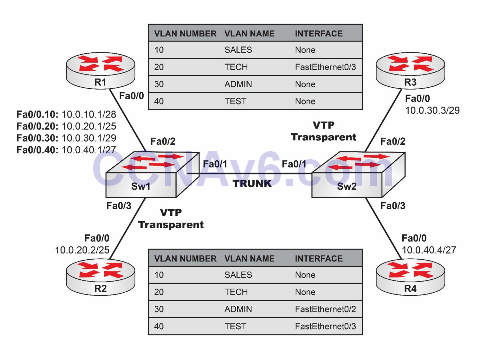Lab Objective:
The objective of this lab exercise is to configure a router to provide inter-VLAN communication. By default, hosts in one VLAN cannot communicate with hosts in another VLAN without a router routing between the two VLANs.
Lab Purpose:
Inter-VLAN routing configuration is a fundamental skill. Most networks typically have more than one VLAN, and the hosts in these VLANs are required to communicate with each other if the need arises. As a Cisco engineer, as well as in the Cisco CCNA exam, you will be expected to know how to configure inter-VLAN routing. In this example, you don’t have a Layer 3 switch so you must use a router to route.
Certification Level:
This lab is suitable for CCNA certification exam preparation.
Lab Difficulty:
This lab has a difficulty rating of 9/10.
Readiness Assessment:
When you are ready for your certification exam, you should complete this lab in no more than 20 minutes.
Lab Topology:
Please use the following topology to complete this lab exercise:

Task 1:
Configure a hostname on switches 1 and 2 and routers 1 through 4 as illustrated in the topology above.
Task 2:
Configure and verify Sw1 and Sw2 as VTP Transparent switches. Both switches should be in the VTP domain named CISCO. Secure VTP messages with the password CISCO.
Task 3:
Configure and verify FastEthernet0/1 between Sw1 and Sw2 as an 802.1q trunk and configure VLANs as depicted in the topology above. Assign ports to depicted VLANs and configure Sw1 FastEthernet0/2 as a trunk. VLAN20 should have untagged Ethernet frames. Remember that on 802.1q trunks, only the native VLAN is untagged.
Task 4:
Configure IP addresses on R2, R3, and R4 as illustrated in the diagram.
Task 5:
Configure subinterfaces off R1 FastEthernet0/0 in the corresponding VLANs in the diagram. Also, configure interface VLAN10 on Sw2 with the IP address 10.0.10.2/28.
Task 6:
Test network connectivity by pinging from R1 to routers R2, R3, and R4.
Configuration and Verification
Task 1:
For reference information on configuring hostnames, please refer to earlier labs.
Task 2:
For reference information on configuring and verifying VTP, please refer to earlier labs.
Task 3:
Sw1#config t Enter configuration commands, one per line. End with CTRL/Z. Sw1(config)#interface fastethernet0/1 Sw1(config-if)#switchport mode trunk Sw1(config-if)#exit Sw1(config)#vlan10 Sw1(config-vlan)#name SALES Sw1(config-vlan)#exit Sw1(config)#vlan20 Sw1(config-vlan)#name TECH Sw1(config-vlan)#exit Sw1(config)#vlan30 Sw1(config-vlan)#name ADMIN Sw1(config-vlan)#exit Sw1(config)#vlan40 Sw1(config-vlan)#name TEST Sw1(config-vlan)#exit Sw1(config)#interface fastethernet0/2 Sw1(config-if)#switchport mode trunk Sw1(config-if)#switchport trunk native vlan20 Sw1(config-if)#exit Sw1(config)#interface fastethernet0/3 Sw1(config-if)#switchport mode access Sw1(config-if)#switchport access vlan20 Sw1(config-if)#end Sw1#show interfaces trunk Port Mode Encapsulation Status Native vlan Fa0/1 on 802.1q trunking 1 Fa0/2 on 802.1q trunking 20 Port Vlans allowed on trunk Fa0/1 1-4094 Fa0/2 1-4094 Port Vlans allowed and active in management domain Fa0/1 1,10,20,30,40 Fa0/2 1,10,20,30,40 Port Vlans in spanning tree forwarding state and not pruned Fa0/1 1,20,30,40 Fa0/2 1,20,30,40 Sw2#config t Enter configuration commands, one per line. End with CTRL/Z. Sw2(config)#interface fastethernet0/1 Sw2(config-if)#switchport mode trunk Sw2(config-if)#exit Sw2(config)#vlan10 Sw2(config-vlan)#name SALES Sw2(config-vlan)#exit Sw2(config)#vlan20 Sw2(config-vlan)#name TECH Sw2(config-vlan)#exit Sw2(config)#vlan30 Sw2(config-vlan)#name ADMIN Sw2(config-vlan)#exit Sw2(config)#vlan40 Sw2(config-vlan)#name TEST Sw2(config-vlan)#exit Sw2(config)#interface fastethernet0/2 Sw2(config-if)#switchport mode access Sw2(config-if)#switchport access vlan30 Sw2(config-if)#exit Sw2(config)#interface fastethernet0/3 Sw2(config-if)#switchport mode access Sw2(config-if)#switchport access vlan40 Sw2(config-if)#^Z Sw2#show interfaces trunk Port Mode Encapsulation Status Native vlan Fa0/1 on 802.1q trunking 1 Port Vlans allowed on trunk Fa0/1 1-4094 Port Vlans allowed and active in management domain Fa0/1 1,10,20,30,40 Port Vlans in spanning tree forwarding state and not pruned Fa0/1 1,20,30,40
Task 4:
For reference information on configuring IP interfaces, please refer to earlier labs.
Task 5:
R1#config t Enter configuration commands, one per line. End with CTRL/Z. R1(config)#interface fastethernet0/0 R1(config-if)#description “Connected To Switch Trunk Fa0/2” R1(config-if)#no shutdown R1(config-if)#exit R1(config)#interface fastethernet0/0.10 R1(config-subif)#description Subinterface For VLAN10 R1(config-subif)#encapsulation dot1Q 10 R1(config-subif)#ip address 10.0.10.1 255.255.255.240 R1(config-subif)#exit R1(config)#interface fastethernet0/0.20 R1(config-subif)#description Subinterface For VLAN20 R1(config-subif)#encapsulation dot1Q 20 native R1(config-subif)#ip address 10.0.20.1 255.255.255.128 R1(config-subif)#exit R1(config)#interface fastethernet0/0.30 R1(config-subif)#description Subinterface For VLAN30 R1(config-subif)#ip address 10.0.30.1 255.255.255.248 R1(config-subif)#exit R1(config)#interface fastethernet0/0.40 R1(config-subif)#description Subinterface For VLAN40 R1(config-subif)#encapsulation dot1Q 40 R1(config-subif)#ip address 10.0.40.1 255.255.255.224 R1(config-subif)#end R1#show ip interface brief Interface IP-Address OK? Method Status Protocol FastEthernet0/0 unassigned YES manual up up FastEthernet0/0.10 10.0.10.1 YES manual up up FastEthernet0/0.20 10.0.20.1 YES manual up up FastEthernet0/0.30 10.0.30.1 YES manual up up FastEthernet0/0.40 10.0.40.1 YES manual up up Sw2(config)#interface vlan1 Sw2(config-if)#shutdown Sw2(config)#interface vlan10 Sw2(config-if)#ip address 10.0.10.2 255.255.255.240 Sw2(config-if)#no shutdown Sw2(config)#^Z Sw2#show ip interface brief Interface IP-Address OK? Method Status Protocol Vlan1 unassigned YES NVRAM administratively down down Vlan10 10.0.10.2 YES manual up up Sw2#
Task 6:
R1#ping 10.0.10.2 Type escape sequence to abort. Sending 5, 100-byte ICMP Echos to 10.0.10.2, timeout is 2 seconds: .!!!! Success rate is 80 percent (4/5), round-trip min/avg/max = 1/3/4 ms R1#ping 10.0.20.2 Type escape sequence to abort. Sending 5, 100-byte ICMP Echos to 10.0.20.2, timeout is 2 seconds: .!!!! Success rate is 80 percent (4/5), round-trip min/avg/max = 1/3/4 ms R1#ping 10.0.30.3 Type escape sequence to abort. Sending 5, 100-byte ICMP Echos to 10.0.30.3, timeout is 2 seconds: .!!!! Success rate is 80 percent (4/5), round-trip min/avg/max = 1/3/4 ms R1#ping 10.0.40.4 Type escape sequence to abort. Sending 5, 100-byte ICMP Echos to 10.0.40.4, timeout is 2 seconds: .!!!! Success rate is 80 percent (4/5), round-trip min/avg/max = 1/3/4 ms
NOTE: The first ping packet times out due to ARP resolution. Subsequent packets will be successful.

Why is there no trunk on R1(config)#interface fastethernet0/0.30 ??
Interface f0/0.30 is a subinterface for VLAN 30. Its not a switchport, so it cannot be a trunk.